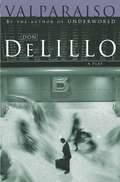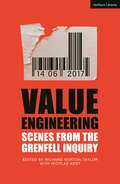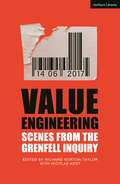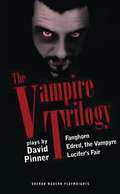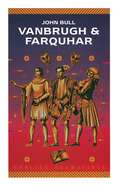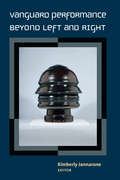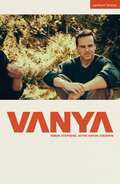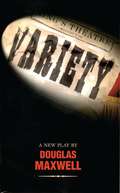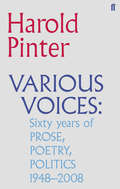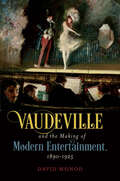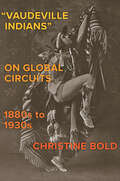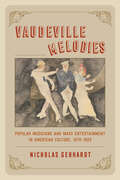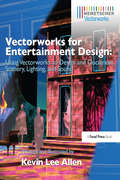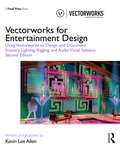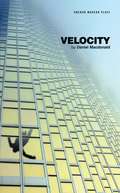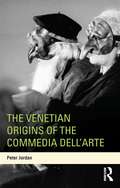- Table View
- List View
Valparaiso
by Don DeLilloIn Valparaiso, a breathtaking play from Don DeLillo, a man sets out on what he imagines will be an ordinary business trip to Valparaiso, Indiana. It proves to be anything but run-of-the-mill, turning instead into a mock-heroic journey toward identity and transcendence. Valparaiso is a funny, sharp and deeply satirical look at our information age. This is the way we talk to each other today. This is the way we tell each other things, in public, before listening millions, that we don't dare say privately. Nothing is allowed to be unseen. Nothing remains unread. And everything melts repeatedly into something else, as if driven by the finger on the TV remote. This is also a play that makes obsessive poetry out of the language of routine airline announcements and the flow of endless information.
Value Engineering: Scenes from the Grenfell Inquiry (Modern Plays)
by Richard Norton-TaylorValue Engineering: Scenes from the Grenfell Inquiry is a verbatim reconstruction of the Grenfell Tower Public Inquiry. Using only the words spoken at the Inquiry, the play deals predominantly with Part 2 which ran between January 2020 - July 2021 in which evidence was heard from those responsible for the disastrous refurbishment of Grenfell Tower before the tragic fire.Edited by Richard Norton-Taylor and directed by Nicholas Kent, the team behind previous testimonial plays The Colour of Justice: The Stephen Lawrence Inquiry and Bloody Sunday: Scenes from the Saville Inquiry, this edited verbatim account of the Grenfell Inquiry is aimed at giving the public an overview and access to some of the most important evidence.The play shows how companies involved in the refurbishment of the Tower conspired to cover up what they knew about the dangerous and life-threatening materials used to refurbish the Tower. It also reveals the incompetence and neglect of local authorities.Staged in Notting Hill Tabernacle in October 2021, this features the full text of the play alongside additional information on the context of Grenfell and the ongoing inquiry.
Value Engineering: Scenes from the Grenfell Inquiry (Modern Plays)
by Richard Norton-TaylorValue Engineering: Scenes from the Grenfell Inquiry is a verbatim reconstruction of the Grenfell Tower Public Inquiry. Using only the words spoken at the Inquiry, the play deals predominantly with Part 2 which ran between January 2020 - July 2021 in which evidence was heard from those responsible for the disastrous refurbishment of Grenfell Tower before the tragic fire.Edited by Richard Norton-Taylor and directed by Nicholas Kent, the team behind previous testimonial plays The Colour of Justice: The Stephen Lawrence Inquiry and Bloody Sunday: Scenes from the Saville Inquiry, this edited verbatim account of the Grenfell Inquiry is aimed at giving the public an overview and access to some of the most important evidence.The play shows how companies involved in the refurbishment of the Tower conspired to cover up what they knew about the dangerous and life-threatening materials used to refurbish the Tower. It also reveals the incompetence and neglect of local authorities.Staged in Notting Hill Tabernacle in October 2021, this features the full text of the play alongside additional information on the context of Grenfell and the ongoing inquiry.
The Vampire Trilogy (Oberon Modern Playwrights)
by David PinnerIncludes the plays Fanghorn, Edred, the Vampire and Lucifer's FairFanghorn is a darkly-surrealistic comedy, which pokes fun at the Theatre of Cruelty. Fanghorn is a lesbian vampire, who invades the household of Joseph King, who may, or may not, be the First Secretary to the Minister of Defence, and hilarious emasculation and murderous mayhem follow in her wake. Edred, the Vampyre is a thousand-year-old Anglo-Saxon bisexual vampire, who slept with Shakespeare, but never bit him. Breaking all Bram Stoker’s vampire laws, Edred loves garlic and crucifixes, so he lives in the village church where he is confronted by two students who Googled him. But soon the students wish they hadn’t.Lucifer’s Fair is the family Hallowe’en musical play, about a fair run by the Devil to entrap unwary children. Lucifer is aided by Fangs, who is a bovver boy by day, but an incompetent vampire by night. Simultaneously scary and funny, Lucifer’s Fair, with its comic spills, thrills and chills, highlights the unreliability of grownups, both the living and the undead.
Vanbrugh and Farquhar (English Dramatists)
by John BullThe plays of Vanbrugh and Farquhar effectively herald the end of the great period of post-Restoration comedy. Both writers, in their very different ways, reflect the larger changes that British society was undergoing as it began to define a modern world. The renewed interest in their work, and the frequent revivals of it on stage, comes not just from an admiration of their reinvigoration of the comic mode, but from their clear articulation of the sense of an old world in conflict with a new. In his exciting new study of the two playwrights, John Bull locates their work both in the context of their own times and in the larger history of theatrical production.
Vanguard Performance Beyond Left and Right
by Kimberly JannaroneVanguard Performance Beyond Left and Right challenges assumptions regarding “radical” and “experimental” performance that have long dominated thinking about the avant-garde. The book brings to light vanguard performances rarely discussed: those that support totalitarian regimes, promote conservative values, or have been effectively snapped up by right-wing regimes the performances intended to oppose. In so doing, the volume explores a central paradox: how innovative performances that challenge oppressive power structures can also be deployed in deliberate, passionate support of oppressive power. Essays by leading international scholars pose engaging questions about the historical avant-garde, vanguard acts, and the complex role of artistic innovation and live performance in global politics. Focusing on performances that work against progressive and democratic ideas (including scripted drama, staged suicide, choral dance, terrorism, rallies, and espionage), the book demonstrates how many compelling performance ideals—unification, exaltation, immersion—are, in themselves, neither moral nor immoral; they are only emotional and aesthetic urges that can be powerfully channeled into a variety of social and political outlets.
Vanya (Modern Plays)
by Anton ChekhovCan you imagine if it was possible to completely change the way you live your life? To look at your life and ask yourself what you would do if it died. If your old life died. It ended. And then take what's left of your real life and live it properly. How can I do that, Michael? Where do I start?Chekhov's classic tale of love, art, sex, and attempted murder in a fresh adaptation by Simon Stephens, written to be performed by a solo actor.Comedic and tragic, Chekhov's examination of our shared humanity – our hopes, dreams, regrets – is thrust into sharp focus in Vanya. This fresh adaptation explores the kaleidoscope of human emotions, harnessing the power of the intimate bond between actor and audience to delve deeper into the human psyche.This edition was published to coincide with the West End premiere starring Andrew Scott in September 2023.
Vanya (Modern Plays)
by Anton ChekhovCan you imagine if it was possible to completely change the way you live your life? To look at your life and ask yourself what you would do if it died. If your old life died. It ended. And then take what's left of your real life and live it properly. How can I do that, Michael? Where do I start?Chekhov's classic tale of love, art, sex, and attempted murder in a fresh adaptation by Simon Stephens, written to be performed by a solo actor.Comedic and tragic, Chekhov's examination of our shared humanity – our hopes, dreams, regrets – is thrust into sharp focus in Vanya. This fresh adaptation explores the kaleidoscope of human emotions, harnessing the power of the intimate bond between actor and audience to delve deeper into the human psyche.This edition was published to coincide with the West End premiere starring Andrew Scott in September 2023.
Variety (Oberon Modern Plays Ser.)
by Douglas MaxwellLadies and gentlemen! Let us present the romantic tenor, the couthy comedian, the speciality act and the equilibrist - a real Concert Party! In its halycon days variety theatre was part of the social life blood of the country. But in the shadow of the enemy - the technological wonder of the talkies - only the bravest or saddest of performers are left reading the boards, in cine-variety.The death throes of one of Scotland's most popular entertainments are chronicled in this world premiere of a new play by Scots playwright Douglas Maxwell, the traditions brought briefly back to pulsating life. Variety was a co-production between Grid Iron Theatre Company and the Edinburgh International Festival.
Various Voices: Prose, Poetry, Politics 1948-2008
by Harold PinterVarious Voices is the only collection of Harold Pinter's prose, poems and political writing to span his career. This new edition includes a remarkable interview in which he reflects on his time as an evacuee in Cornwall during the Second World War, as well as new prose, poems and his Nobel Speech.
Vaudeville and the Making of Modern Entertainment, 1890–1925
by David MonodToday, vaudeville is imagined as a parade of slapstick comedians, blackface shouters, coyly revealed knees, and second-rate acrobats. But vaudeville was also America's most popular commercial amusement from the mid-1890s to the First World War; at its peak, 5 million Americans attended vaudeville shows every week. Telling the story of this pioneering art form's rise and decline, David Monod looks through the apparent carnival of vaudeville performance and asks: what made the theater so popular and transformative? Although he acknowledges its quirkiness, Monod makes the case that vaudeville became so popular because it offered audiences a guide to a modern urban lifestyle. Vaudeville acts celebrated sharp city styles and denigrated old-fashioned habits, showcased new music and dance moves, and promulgated a deeply influential vernacular modernism. The variety show's off-the-rack trendiness perfectly suited an era when goods and services were becoming more affordable and the mass market promised to democratize style, offering a clear vision of how the quintessential twentieth-century citizen should look, talk, move, feel, and act.
“Vaudeville Indians†? on Global Circuits, 1880s-1930s (The Henry Roe Cloud Series on American Indians and Modernity)
by Christine BoldUncovering hidden histories of Indigenous performers in vaudeville and in the creation of western modernity and popular culture
Vaudeville Melodies: Popular Musicians and Mass Entertainment in American Culture, 1870-1929
by Nicholas GebhardtIf you enjoy popular music and culture today, you have vaudeville to thank. From the 1870s until the 1920s, vaudeville was the dominant context for popular entertainment in the United States, laying the groundwork for the music industry we know today. In Vaudeville Melodies, Nicholas Gebhardt introduces us to the performers, managers, and audiences who turned disjointed variety show acts into a phenomenally successful business. First introduced in the late nineteenth century, by 1915 vaudeville was being performed across the globe, incorporating thousands of performers from every branch of show business. Its astronomical success relied on a huge network of theatres, each part of a circuit and administered from centralized booking offices. Gebhardt shows us how vaudeville transformed relationships among performers, managers, and audiences, and argues that these changes affected popular music culture in ways we are still seeing today. Drawing on firsthand accounts, Gebhardt explores the practices by which vaudeville performers came to understand what it meant to entertain an audience, the conditions in which they worked, the institutions they relied upon, and the values they imagined were essential to their success.
Vaudeville Melodies: Popular Musicians and Mass Entertainment in American Culture, 1870-1929
by Nicholas GebhardtIf you enjoy popular music and culture today, you have vaudeville to thank. From the 1870s until the 1920s, vaudeville was the dominant context for popular entertainment in the United States, laying the groundwork for the music industry we know today. In Vaudeville Melodies, Nicholas Gebhardt introduces us to the performers, managers, and audiences who turned disjointed variety show acts into a phenomenally successful business. First introduced in the late nineteenth century, by 1915 vaudeville was being performed across the globe, incorporating thousands of performers from every branch of show business. Its astronomical success relied on a huge network of theatres, each part of a circuit and administered from centralized booking offices. Gebhardt shows us how vaudeville transformed relationships among performers, managers, and audiences, and argues that these changes affected popular music culture in ways we are still seeing today. Drawing on firsthand accounts, Gebhardt explores the practices by which vaudeville performers came to understand what it meant to entertain an audience, the conditions in which they worked, the institutions they relied upon, and the values they imagined were essential to their success.
Vaudeville Melodies: Popular Musicians and Mass Entertainment in American Culture, 1870-1929
by Nicholas GebhardtIf you enjoy popular music and culture today, you have vaudeville to thank. From the 1870s until the 1920s, vaudeville was the dominant context for popular entertainment in the United States, laying the groundwork for the music industry we know today. In Vaudeville Melodies, Nicholas Gebhardt introduces us to the performers, managers, and audiences who turned disjointed variety show acts into a phenomenally successful business. First introduced in the late nineteenth century, by 1915 vaudeville was being performed across the globe, incorporating thousands of performers from every branch of show business. Its astronomical success relied on a huge network of theatres, each part of a circuit and administered from centralized booking offices. Gebhardt shows us how vaudeville transformed relationships among performers, managers, and audiences, and argues that these changes affected popular music culture in ways we are still seeing today. Drawing on firsthand accounts, Gebhardt explores the practices by which vaudeville performers came to understand what it meant to entertain an audience, the conditions in which they worked, the institutions they relied upon, and the values they imagined were essential to their success.
Vaudeville Melodies: Popular Musicians and Mass Entertainment in American Culture, 1870-1929
by Nicholas GebhardtIf you enjoy popular music and culture today, you have vaudeville to thank. From the 1870s until the 1920s, vaudeville was the dominant context for popular entertainment in the United States, laying the groundwork for the music industry we know today. In Vaudeville Melodies, Nicholas Gebhardt introduces us to the performers, managers, and audiences who turned disjointed variety show acts into a phenomenally successful business. First introduced in the late nineteenth century, by 1915 vaudeville was being performed across the globe, incorporating thousands of performers from every branch of show business. Its astronomical success relied on a huge network of theatres, each part of a circuit and administered from centralized booking offices. Gebhardt shows us how vaudeville transformed relationships among performers, managers, and audiences, and argues that these changes affected popular music culture in ways we are still seeing today. Drawing on firsthand accounts, Gebhardt explores the practices by which vaudeville performers came to understand what it meant to entertain an audience, the conditions in which they worked, the institutions they relied upon, and the values they imagined were essential to their success.
Vaudeville Melodies: Popular Musicians and Mass Entertainment in American Culture, 1870-1929
by Nicholas GebhardtIf you enjoy popular music and culture today, you have vaudeville to thank. From the 1870s until the 1920s, vaudeville was the dominant context for popular entertainment in the United States, laying the groundwork for the music industry we know today. In Vaudeville Melodies, Nicholas Gebhardt introduces us to the performers, managers, and audiences who turned disjointed variety show acts into a phenomenally successful business. First introduced in the late nineteenth century, by 1915 vaudeville was being performed across the globe, incorporating thousands of performers from every branch of show business. Its astronomical success relied on a huge network of theatres, each part of a circuit and administered from centralized booking offices. Gebhardt shows us how vaudeville transformed relationships among performers, managers, and audiences, and argues that these changes affected popular music culture in ways we are still seeing today. Drawing on firsthand accounts, Gebhardt explores the practices by which vaudeville performers came to understand what it meant to entertain an audience, the conditions in which they worked, the institutions they relied upon, and the values they imagined were essential to their success.
Vaudeville Melodies: Popular Musicians and Mass Entertainment in American Culture, 1870-1929
by Nicholas GebhardtIf you enjoy popular music and culture today, you have vaudeville to thank. From the 1870s until the 1920s, vaudeville was the dominant context for popular entertainment in the United States, laying the groundwork for the music industry we know today. In Vaudeville Melodies, Nicholas Gebhardt introduces us to the performers, managers, and audiences who turned disjointed variety show acts into a phenomenally successful business. First introduced in the late nineteenth century, by 1915 vaudeville was being performed across the globe, incorporating thousands of performers from every branch of show business. Its astronomical success relied on a huge network of theatres, each part of a circuit and administered from centralized booking offices. Gebhardt shows us how vaudeville transformed relationships among performers, managers, and audiences, and argues that these changes affected popular music culture in ways we are still seeing today. Drawing on firsthand accounts, Gebhardt explores the practices by which vaudeville performers came to understand what it meant to entertain an audience, the conditions in which they worked, the institutions they relied upon, and the values they imagined were essential to their success.
Vectorworks for Entertainment Design: Using Vectorworks to Design and Document Scenery, Lighting, and Sound
by Kevin Lee AllenThe first book in the industry tailored specifically for the entertainment professional, Vectorworks for Entertainment Design covers the ins and outs of Vectorworks software for lighting, scenic, and sound design. With a detailed look at the design process, from idea to development, to the documentation necessary for execution, Vectorworks for Entertainment Design will encourage you to create your own process and workflow through exercises that build on one another. The text stresses the process of developing an idea, visualizing it, and evolving it for presentation, documentation, or drafting. The author focuses on both the technical how-to and the art of design, giving you the tools you need to learn and then use the application professionally. Fully illustrated with step-by-step instructions, it contains inspirational work from Broadway, major regional companies, and non-theatrical, entertainment design.
Vectorworks for Entertainment Design: Using Vectorworks to Design and Document Scenery, Lighting, and Sound
by Kevin Lee AllenThe first book in the industry tailored specifically for the entertainment professional, Vectorworks for Entertainment Design covers the ins and outs of Vectorworks software for lighting, scenic, and sound design. With a detailed look at the design process, from idea to development, to the documentation necessary for execution, Vectorworks for Entertainment Design will encourage you to create your own process and workflow through exercises that build on one another. The text stresses the process of developing an idea, visualizing it, and evolving it for presentation, documentation, or drafting. The author focuses on both the technical how-to and the art of design, giving you the tools you need to learn and then use the application professionally. Fully illustrated with step-by-step instructions, it contains inspirational work from Broadway, major regional companies, and non-theatrical, entertainment design.
Vectorworks for Entertainment Design: Using Vectorworks to Design and Document Scenery, Lighting, Rigging and Audio Visual Systems
by Kevin Lee AllenVectorworks for Entertainment Design is the first book in the industry tailored for the entertainment professional. This second edition has been extensively revised and updated, covering the most current details of the Vectorworks software for scenery, lighting, sound, and rigging. With a focused look at the production process from ideation to development to documentation required for proper execution, the book encourages readers to better create their own processes and workflows through exercises that build on one another. This new edition introduces Braceworks, SubDivision modeling, and scripting using the Marionette tool, and covers new tools such as Video Camera, Deform Tool, Camera Match, Schematic Views, and Object Styles. Fully illustrated with step-by-step instructions, this volume contains inspirational and aspirational work from Broadway, Concerts, Regional Theatre, Dance, and Experiential Entertainment. Exploring both the technical how-to and the art of design, this book provides Theatre and Lighting Designers with the tools to learn about the application and use it professionally. Vectorworks for Entertainment Design also includes access to downloadable resources such as exercise files and images to accompany projects discussed within the book.
Vectorworks for Entertainment Design: Using Vectorworks to Design and Document Scenery, Lighting, Rigging and Audio Visual Systems
by Kevin Lee AllenVectorworks for Entertainment Design is the first book in the industry tailored for the entertainment professional. This second edition has been extensively revised and updated, covering the most current details of the Vectorworks software for scenery, lighting, sound, and rigging. With a focused look at the production process from ideation to development to documentation required for proper execution, the book encourages readers to better create their own processes and workflows through exercises that build on one another. This new edition introduces Braceworks, SubDivision modeling, and scripting using the Marionette tool, and covers new tools such as Video Camera, Deform Tool, Camera Match, Schematic Views, and Object Styles. Fully illustrated with step-by-step instructions, this volume contains inspirational and aspirational work from Broadway, Concerts, Regional Theatre, Dance, and Experiential Entertainment. Exploring both the technical how-to and the art of design, this book provides Theatre and Lighting Designers with the tools to learn about the application and use it professionally. Vectorworks for Entertainment Design also includes access to downloadable resources such as exercise files and images to accompany projects discussed within the book.
Velocity (Oberon Modern Plays)
by Daniel Macdonald‘Everyone falls at the same rate. Isn’t that amazing? Everyone. Everything. A fat man. A little baby. A brick, a piece of paper, a penny. Amazing. Once acceleration gets a hold of you velocity just goes all fuckin’ nuts’ Dot doesn't hate her father, she just wants to explode him out of his office tower to shake things up. Set him off. See what happens. And get an "A" on her science project... Daring to challenge the law of physics, Dot interviews her flailing father and neurotic mother, as their world crashes to the ground. Just imagine. Your life in six seconds.
The Venetian Origins of the Commedia dell'Arte
by Peter JordanThe Venetian Origins of the Commedia dell'Arte is a striking new enquiry into the late-Renaissance stirrings of professional secular comedy in Venice, and their connection to the development of what came to be known as the Commedia dell’Arte. The book contends that through a symbiotic collaboration between patrician amateurs and plebeian professionals, innovative forms of comedy developed in the Venice region, fusing ‘high’ and ‘low’ culture in a provocative mix that had a truly mass appeal. Rich with anecdotes, diary entries and literary – often ribald – comic passages, Peter Jordan's central argument has important implications for the study of Venetian art, popular theatre and European cultural history.
The Venetian Origins of the Commedia dell'Arte
by Peter JordanThe Venetian Origins of the Commedia dell'Arte is a striking new enquiry into the late-Renaissance stirrings of professional secular comedy in Venice, and their connection to the development of what came to be known as the Commedia dell’Arte. The book contends that through a symbiotic collaboration between patrician amateurs and plebeian professionals, innovative forms of comedy developed in the Venice region, fusing ‘high’ and ‘low’ culture in a provocative mix that had a truly mass appeal. Rich with anecdotes, diary entries and literary – often ribald – comic passages, Peter Jordan's central argument has important implications for the study of Venetian art, popular theatre and European cultural history.
